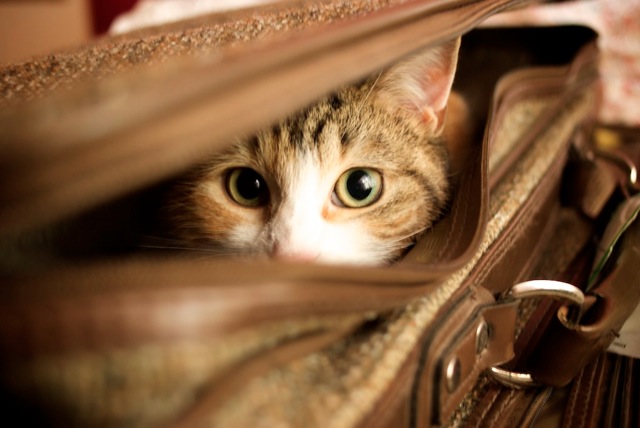Flight for an animal is stressful. It’s stressful for both the pet and the owner and involves a monumental amount of work and preparation. Your feline friend will be exposed to some terrifying and loud experiences as well as painful pressure changes.
But, if you can’t be parted from your little friend, there are some things that you can do to make the process less distressing. Once your animal has settled into his new environment, the chances are both of you will be much happier than if you had left him at home, lonely and restless.
Sedatives can be risky as it is unknown how this will react at altitude with your cat. There is a product that acts like a sedative called Acepromazine. It works by slowing down the senses, resulting in a chilled out relaxed animal. It’s normally given around 45 minutes prior to flying, but this will depend on her weight. A good idea is to test it out a couple of days before your journey to judge when it’s best to administer it.
Animals within the EU have a Pet Passport. Once you have got your animal into a European country, it is highly recommended that you get one of these. Returning to the US is a much easier exercise, as you have already gone through the European process.
Airline Tickets
Check different airlines for their restrictions and regulations for allowing pets onto their cabins. Some allow PETC (pets in cabin) and some don’t. Others will allow a certain number of pets but only in a particular class. You cannot fly to the UK with a pet in the cabin, even if you are just passing through and do not disembark.
The airlines which currently do NOT allow pets in the cabin for international routes are: USAir, Singapore Air, Air Canada, Iceland Air, Scandinavian Air, UAL Business/First Class, and British Airways.
Microchipping is a Must
Microchipping your pet is the preferred method of identity marking. If your animal was tattooed prior to 3 July 2011, it is acceptable providing this is clear and legible. However, a microchip contains numbers specific to your animal and is preferred.
The international Standards Organizations (ISO) have an approved system for microchipping and use the ISO 11784 chip which is recognized by standard global scanners. You can still use the standard American microchip, but you will need to bring your own microchip scanner. Should you lose your kitty, this microchip will make things much easier to identify her.
Rabies Vaccination
You must get your cat an approved rabies vaccination before entering any EU destination. This is a huge concern to EU countries and the rules are very strict. This must be done after micro-chipping (or alongside). Countries in the EU differ with vaccination requirements, so it’s best to research these while planning your trip.
For example, France has a requirement for your pet to be vaccinated against infectious feline leucopenia. This needs to be tested three months before you intend to travel and the UK require it to be tested six months prior to travel.
Most rabies vaccinations will last 2-3 years. However, depending on which country you are visiting, you may need to have this done no more than 12 months from your intended time of travel.
Have a Titer/Blood Test Done
This is a basic blood test which is performed as a ‘control’ to prove that the rabies vaccination has worked properly. It needs to be done 30 days after the rabies test.
Get USDA Endorsed
You will need to find a vet who is USDA (United States Department of Agriculture) approved and have a Veterinary Certificate E9.163 completed and sent to USDA for endorsement. Each airline is different as far as how close to travel they require this, so it’s best to give whoever you book with a call to find out their policy.
Some airlines require the “international Health Certificate” or the “Bilingual Heath Certificate” which shows that the animal is healthy and disease free. Your vet will have to do a consultation for this to examine your pet.
It’s Time to Fly!
Make sure you take all of the certificates and documents for your pet and declare at customs that you are importing an animal. Some airlines will need to see a receipt to prove that you have paid extra for your pet and this tends to get checked at the gate.
When you go through the metal detector you will need to take your cat out of her transporter and carry her through, but make sure you take off her collar as this may make the detector go off.
Get an EU Pet Passport
EU Pet Passports are available for cats, dogs, and ferrets and are designed to last for the lifetime of your pet. You may enter the UK and other EU destinations without the need for a Pet Passport or quarantine providing you follow the rules for the pet travel scheme.
However, once in the EU and you intend to travel within Member States of the European Union, you will find life a lot easier if you get an EU Pet Passport.
Neighboring countries outside the EU, including Andora, Iceland, Liechtenstein, Monaco, Norway, San Marino, Switzerland, and the Vatican City will accept the EU Passport. Non-continental countries will also accept an EU Pet Passport including Greenland and the Faroe Islands, French Guiana, Guadeloupe, Martinique, Reunion, Canary Islands, Azores and Madeira, and Gibraltar.
If you are applying in the UK you will need to find an “official Veterinarian” (OV), who are the only vets who are able to issue EU Pet Passports. You will need your cat’s vaccination records and evidence of her microchipping.

 En
En Es
Es Fr
Fr